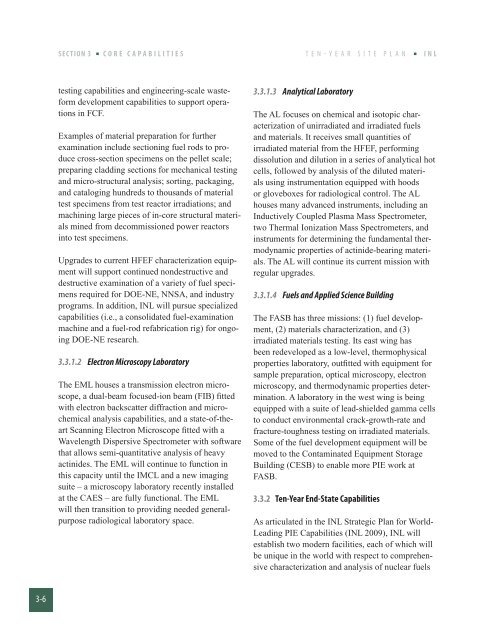2013-2022 TEN-YEAR SITE PLAN - Idaho National Laboratory
2013-2022 TEN-YEAR SITE PLAN - Idaho National Laboratory
2013-2022 TEN-YEAR SITE PLAN - Idaho National Laboratory
You also want an ePaper? Increase the reach of your titles
YUMPU automatically turns print PDFs into web optimized ePapers that Google loves.
3-6<br />
SECTION 3 CORE CAPABILITIES<br />
testing capabilities and engineering-scale wasteform<br />
development capabilities to support operations<br />
in FCF.<br />
Examples of material preparation for further<br />
examination include sectioning fuel rods to produce<br />
cross-section specimens on the pellet scale;<br />
preparing cladding sections for mechanical testing<br />
and micro-structural analysis; sorting, packaging,<br />
and cataloging hundreds to thousands of material<br />
test specimens from test reactor irradiations; and<br />
machining large pieces of in-core structural materials<br />
mined from decommissioned power reactors<br />
into test specimens.<br />
Upgrades to current HFEF characterization equipment<br />
will support continued nondestructive and<br />
destructive examination of a variety of fuel specimens<br />
required for DOE-NE, NNSA, and industry<br />
programs. In addition, INL will pursue specialized<br />
capabilities (i.e., a consolidated fuel-examination<br />
machine and a fuel-rod refabrication rig) for ongoing<br />
DOE-NE research.<br />
3.3.1.2 Electron Microscopy <strong>Laboratory</strong><br />
The EML houses a transmission electron microscope,<br />
a dual-beam focused-ion beam (FIB) fitted<br />
with electron backscatter diffraction and microchemical<br />
analysis capabilities, and a state-of-theart<br />
Scanning Electron Microscope fitted with a<br />
Wavelength Dispersive Spectrometer with software<br />
that allows semi-quantitative analysis of heavy<br />
actinides. The EML will continue to function in<br />
this capacity until the IMCL and a new imaging<br />
suite – a microscopy laboratory recently installed<br />
at the CAES – are fully functional. The EML<br />
will then transition to providing needed generalpurpose<br />
radiological laboratory space.<br />
3.3.1.3 Analytical <strong>Laboratory</strong><br />
T E N - Y E A R S I T E P L A N INL<br />
The AL focuses on chemical and isotopic characterization<br />
of unirradiated and irradiated fuels<br />
and materials. It receives small quantities of<br />
irradiated material from the HFEF, performing<br />
dissolution and dilution in a series of analytical hot<br />
cells, followed by analysis of the diluted materials<br />
using instrumentation equipped with hoods<br />
or gloveboxes for radiological control. The AL<br />
houses many advanced instruments, including an<br />
Inductively Coupled Plasma Mass Spectrometer,<br />
two Thermal Ionization Mass Spectrometers, and<br />
instruments for determining the fundamental thermodynamic<br />
properties of actinide-bearing materials.<br />
The AL will continue its current mission with<br />
regular upgrades.<br />
3.3.1.4 Fuels and Applied Science Building<br />
The FASB has three missions: (1) fuel development,<br />
(2) materials characterization, and (3)<br />
irradiated materials testing. Its east wing has<br />
been redeveloped as a low-level, thermophysical<br />
properties laboratory, outfitted with equipment for<br />
sample preparation, optical microscopy, electron<br />
microscopy, and thermodynamic properties determination.<br />
A laboratory in the west wing is being<br />
equipped with a suite of lead-shielded gamma cells<br />
to conduct environmental crack-growth-rate and<br />
fracture-toughness testing on irradiated materials.<br />
Some of the fuel development equipment will be<br />
moved to the Contaminated Equipment Storage<br />
Building (CESB) to enable more PIE work at<br />
FASB.<br />
3.3.2 Ten-Year End-State Capabilities<br />
As articulated in the INL Strategic Plan for World-<br />
Leading PIE Capabilities (INL 2009), INL will<br />
establish two modern facilities, each of which will<br />
be unique in the world with respect to comprehensive<br />
characterization and analysis of nuclear fuels

















